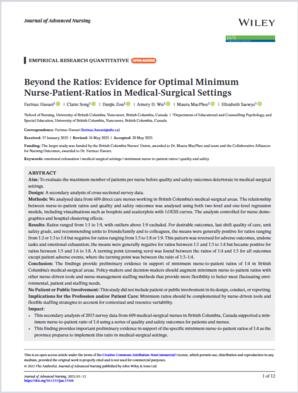MacPhee, Maura
Person Preferred Name
Maura MacPhee
Related Works
Content type
Digital Document
Abstract
Aim: To evaluate the maximum number of patients per nurse before quality and safety outcomes deteriorate in medical-surgical settings.
Design: A secondary analysis of cross-sectional survey data.
Conclusion: The findings provide preliminary evidence in support of minimum nurse-to-patient ratios of 1:4 in British Columbia's medical-surgical areas. Policy-makers and decision-makers should augment minimum nurse-to-patient ratios with other nurse-driven tools and nurse-management staffing methods that provide more flexibility to better meet fluctuating environmental, patient and staffing needs.
No patient or public involvement: This study did not include patient or public involvement in its design, conduct, or reporting.
Origin Information
Content type
Digital Document
Abstract
The learning initiative called the British Columbia Nursing Administrative Leadership Institute (BCNLI) for first line nurse leaders was developed to address the need for educating and mentoring new nurse leaders. The program was a joint project between the Ministry of Health Services Nursing Directorate, British Columbia’s Chief Nursing Officers and the School of Nursing at UBC. The BCNLI program is evidenced based and included information on leadership, management concepts and relevant issues for leaders, (MacPhee & Bouthillette, 2008). The front line nurse leaders who participated were provided education and mentoring, to increase their skills. The front line nursing leaders selected year long projects as part of the program. This study examined if there was any change to the types and scope of control of projects front line nurse leaders chose as part of learning and mentoring initiative. 211 nurse leaders’ projects from the BCNLI project data web pages were examined for scope of control, type of project, and Donabedian’s (1982) structure process outcomes framework using content analysis (Graneheim & Lundman, 2004). These projects provide a window to the types of issues that were relevant and seen as important to the front line nurse leader participants in each cohort of the BCNLI program from 2007 to 2010. This research found that there was no change between the nine cohorts as to structure or process coding. The majority of the projects were structure coded. The content analysis identified five main themes of recruitment/retenton, communication, education, care delivery evaluation, and tool development. The ability to identify the scope of projects of front line nurse leaders was important as very little research exists on scope of control for front line nurse leaders. Only 61% of the projects are at the nursing unit or front line (level two) position. There are concerns that front line nurse leaders were working beyond the nursing unit level. This research will help to understand if nurse leaders are taking on issues or problems that are beyond their roles and the type of projects that exist in the British Columbia Health Care.
Origin Information


